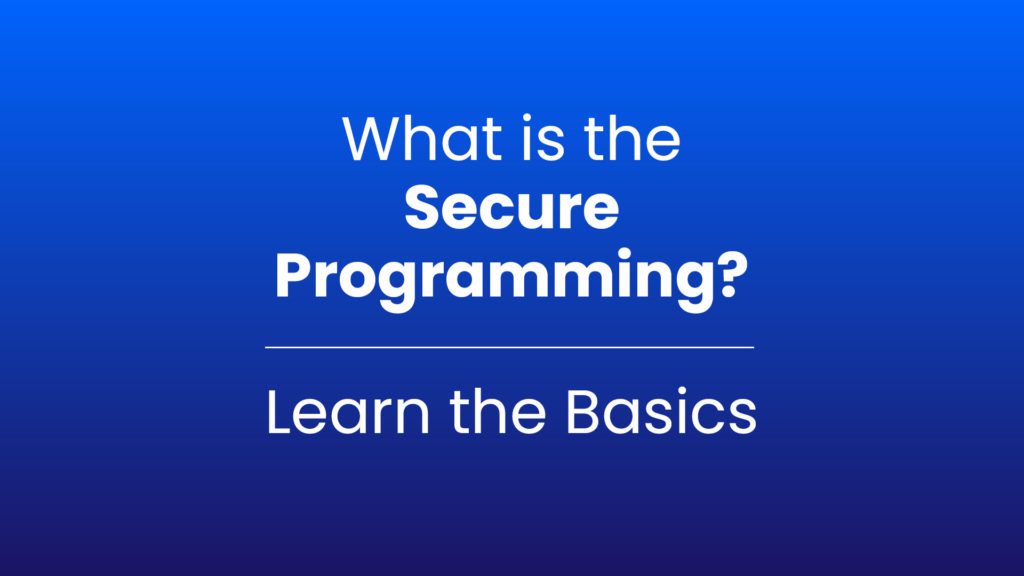Despite a growing national and individual emphasis on digital security, cyberattacks continue to increase on a local and global level. As a result, developers have become increasingly overwhelmed by the necessity of creating and managing breach-proof code.
Fortunately, it’s possible to achieve critical safety through basic security principles. Understanding what leads to insecure code, how to identify ensuing vulnerabilities, and which practices prevent errors simplifies this daunting task.
What Is Secure Coding?
Failing to consider security leaves code open to malicious attacks and hackers. Coding professionals must therefore implement a series of best practices to ensure protection against vulnerabilities.
The processes for securing code are generally straightforward. The majority of vulnerabilities result from a logic flaw, defect, or bug. This limited error scope makes it easier to identify and correct the mistakes responsible for the safety flaw. By following specific security guidelines, however, coders can avoid these errors in the first place.
The Importance of Secure Coding
Since errors tend to arise from the same few sources, cyber predators know where to look for potential vulnerabilities. Any code containing vulnerabilities is susceptible to attack, so implementing stringent security measures is the best way to minimize exposure and reduce the chances of falling victim to a violation.
The Risks of Not Having Secure Coding
Having your code exploited is only one negative side effect of insecure code. Widespread cyberattacks, especially those that prey upon private customer data, can prove detrimental to a company’s reputation. One major breach can be enough to ruin even the most respected, well-established business.
What Are the Best Secure Coding Techniques?
Identifying the most common security errors is a great place to start when determining ideal secure coding practices. Frequent offenders include:
- Unprotected sensitive data (login credentials, contact information, etc.)
- Inadequate or infrequent logging and monitoring
- Vulnerable injections
- Unmonitored access to systems and data
- Insecure or inaccurate configuration
- Ignored existing vulnerabilities
While this list is not exhaustive, software developers can implement simple policies to prevent these basic insecure practices from becoming catastrophic security threats. Standard security measures may require slight tweaks to fit each company’s needs, but these essential secure coding techniques reduce detectable vulnerabilities dramatically.
Better Authentication Management
Unmanaged login authentication is one of the simplest ways to introduce a security threat. Typically, each system user has a unique identification code and password. While necessary for protecting personal information, individual credentials create hundreds if not thousands of opportunities for hackers to break into a system.
To avoid potential vulnerabilities, enforce more robust password creation and recovery methods. Requiring that passwords be a particular length or contain special characters makes it more difficult for cyber thieves to steal credentials. Many companies also encourage or require employees to change their passwords once or twice a year to minimize risks.
Another easy way to practice enhanced security management is to ask that all users rely on two-factor authentication, which introduces an additional protective step. Two-factor authentication, often abbreviated as 2FA, asks that users provide a password and a unique single-use code to log in. This extra layer of protection lessens the probability that a hacker can crack a user’s credential code.
Frequent Logging and Monitoring
Error handling, logging, and monitoring must be continual to ensure adequate security. Error checks allow developers to identify and correct coding vulnerabilities without interrupting software access.
Unfortunately, many software development companies fail to monitor their code sufficiently, and the consequences can prove detrimental. The first complication of inadequate error handling is greater vulnerability exposure. When a vulnerability flies under the radar, cyber attackers have a more extended period in which they can exploit that vulnerability.
Another result of infrequent logging and monitoring is the failure to notice that a breach has occurred. It can be months before companies realize they are under attack. A prolonged attack creates even more room for thievery and exploitation. Error checks should be frequent and thorough to ensure minimal data exposure.
Protected Personal Data
While protecting data is similar to authentication management, it focuses more on the bigger picture of data security rather than individual credential regulation. Data protection involves a company’s comprehensive policies and enforceable efforts to keep unwanted eyes off private information.
Many data protection policies center around proper storage and limited access to the system. Better data protection is often a built-in feature of modern storage systems such as the cloud, a universal and highly accessible storage solution. It’s also wise to manually or periodically delete older data that is no longer needed or relevant.
Use firewalls, endpoint protection, and encryption keys to limit access to company systems. Since they fall on the company rather than the employees, these protections make policy implementation more uniform and generally more successful. Wide Scale protections are usually part of a company-wide data loss prevention plan developed by a special team of coding security experts.
Increased Data Validity Checks
Input validation is the process by which a system monitors the data entered into it. Without it, attackers can input malicious code or commands, causing a system to fail or otherwise malfunction. A validity breach can also leak sensitive data or memory and open up room for an injection attack.
The most basic principle of input validation is analyzing any incoming data from an outside party. Blacklisting this data prevents access but leaves room for error, as blacklisting requires developers and programmers to anticipate unfamiliar data before they can block it. Whitelisting, on the other hand, is much safer, as it enables only a specific list of users to access the data and thus allows users to input only expected data.
Enhanced Secure Communication
While some communication-concerning code is inherently secure, it’s still possible for outsiders to access telecommunications. For this reason, digital security experts must constantly work to develop more secure ways to convey sensitive information to third-party individuals or teams.
Transport Layer Security, or TLS, allows developers to share information in a protected environment. Protection extends to emails, direct messaging, Voice over Internet Protocol (VoIP), and Hypertext Transfer Protocol Secure (HTTPS). As a national security effort created by the Internet Engineering Task Force, TLS offers users a safe communication pathway for sharing protected data through a client-server application.
Customized Security Standards
Despite strict nationwide and inter-business policies, individual companies often require custom rules to address their security needs adequately. Standards should cater to the particular platform and coding language on which a team relies to ensure all security bases are covered.
What Is Secure Coding Certification?
Secure Coding Certification teaches developers how to increase effective safety measures and uphold security protocols in a monitored and often self-paced environment. There are countless training courses available, most of which help developers get organized and streamline the certification process, as both administrators and developers tire of tedious training courses. Classes also give developers the opportunity to apply their knowledge in a safe environment before transferring those skills to real code. Security Coding Certification, primarily through organized training courses, is a straightforward way to learn more about these techniques and increase individual and company-wide digital safety.
Improving software security may not happen overnight, but many secure coding techniques are easy to master, implement, and reinforce. In addition to following some of these secure coding techniques, SOOS offers a great Software Composition Analysis tool for your DevSecOps team to keep in their tool kit.












